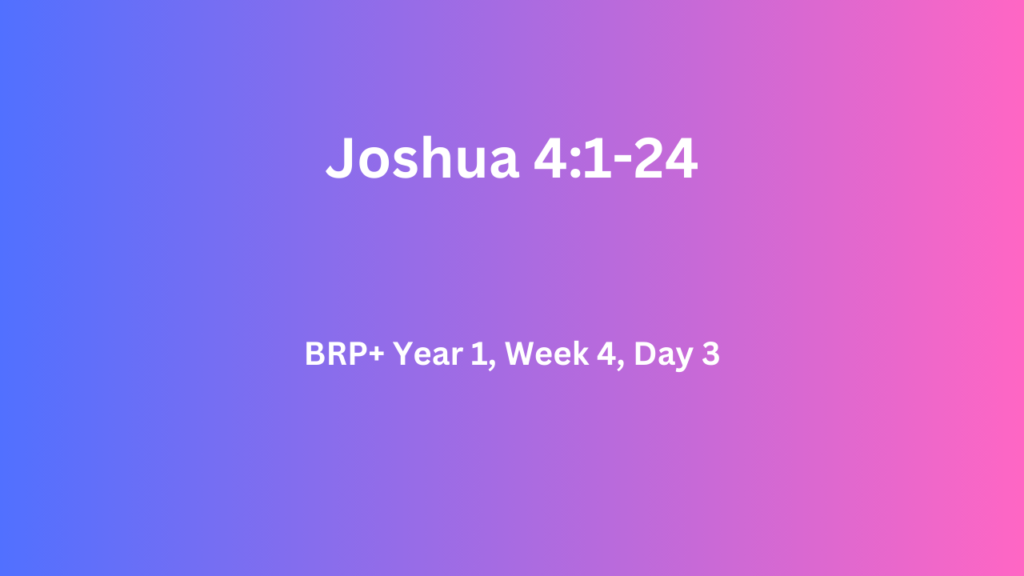Joshua 4:1-24
Q.1. Did the pathway through the Jordan River disappear once Israel crossed? What command did God give Joshua? What was the point of the twelve-stone monument? – (Josh.4:1-7)
The whole nation had crossed the Jordan. Only the priests carrying the ark were still in the river. God then spoke to Joshua and commanded him to gather twelve men representing each of the tribes. They were to carry a stone boulder from the middle of the river and take it to their camp in the Promised Land. Joshua then formed the stones into a monument (Josh.4:1-5,9). Those memorial stones were to be a permanent reminder of this miraculous crossing. When future generations asked about the meaning of the monument, the older people were to remind them – … Because the waters of the Jordan were cut off before the ark of the covenant of the Lord; when it crossed the Jordan, the waters of the Jordan were cut off.’ So, these stones shall become a memorial to the sons of Israel forever (Josh.4:7).
Q.2. Why were twelve boulders also placed in the middle of the Jordan? Why did the priests stay in the Jordan River? Why were only some of the tribes mentioned? – (Josh.4:8-13 c.f. Num.32:1-42)
Joshua also repeated this ‘witness’ to the miracle. He – set up twelve stones in the middle of the Jordan at the place where the feet of the priests who carried the ark of the covenant were standing, and they are there to this day (Josh.4:9). The stones in the Promised Land bore testimony to the stones in the Jordan River. This is not unlike the public declaration at baptism, which represents the ‘unseen’ work that the Lord has done in the heart of a convert. The priests had no power, either to divide or to hold back the flooded Jordan. However, they carried the ark … and the ark represented the Lord of the whole earth, so – It shall come about when the soles of the feet of the priests who carry the ark of the Lord, the Lord of all the earth, rest in the waters of the Jordan, the waters of the Jordan will be cut off, and the waters which are flowing down from above will stand in one heap (Josh.3:13 c.f. 3:11). The tribes of Reuben, Gad, and the half tribe of Manasseh had settled with their huge flocks on the land Israel had conquered east of the Jordan River, while Moses was still alive. They had agreed that all their able-bodied men would join the rest of Israel, in conquering the Promised Land (Num.32:1-42). True to their word, their army of forty thousand men, equipped for battle, joined Israel (Josh.4:12-13 c.f. Num.32:17-19).
Q.3. When did the flood waters return? What made the growing respect for Joshua crucial? To whom was the stone monument a sign and witness? – (Josh.4:14-24)
At the direction of God and the command of Joshua – It came about when the priests who carried the ark of the covenant of the Lord had come up from the middle of the Jordan, and the soles of the priests’ feet were lifted up to the dry ground, that the waters of the Jordan returned to their place and went over all its banks as before (Josh.4:18). This new generation had highly respected Moses. Now, their respect was transferred to Joshua, through the miraculous crossing of the Jordan (Josh.4:14 c.f. Heb.13:17). The stone monument would be a permanent reminder to future Israelites, of the miraculous beginning in their Promised Land (Josh.4:21-23). Rahab had already informed the Israeli spies about the fearful reputation of the nation. This crossing would add to their awe of God’s people – that all the peoples of the earth may know that the hand of the Lord is mighty, so that you may fear the Lord your God forever (Josh.4:24 c.f. Josh.2:9-11).

